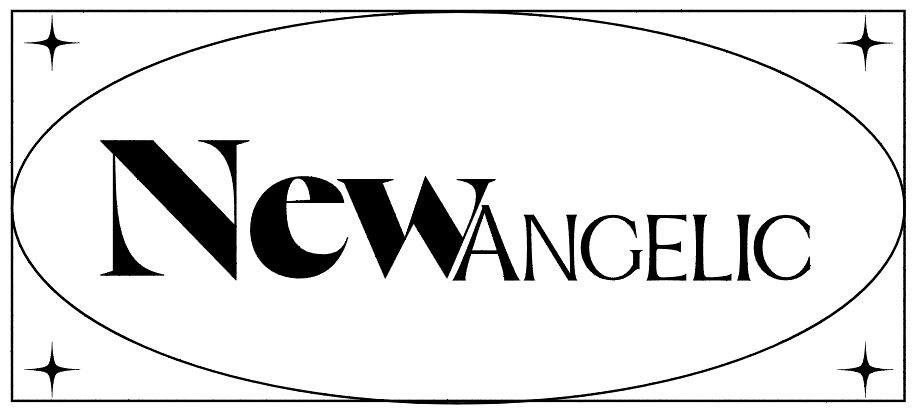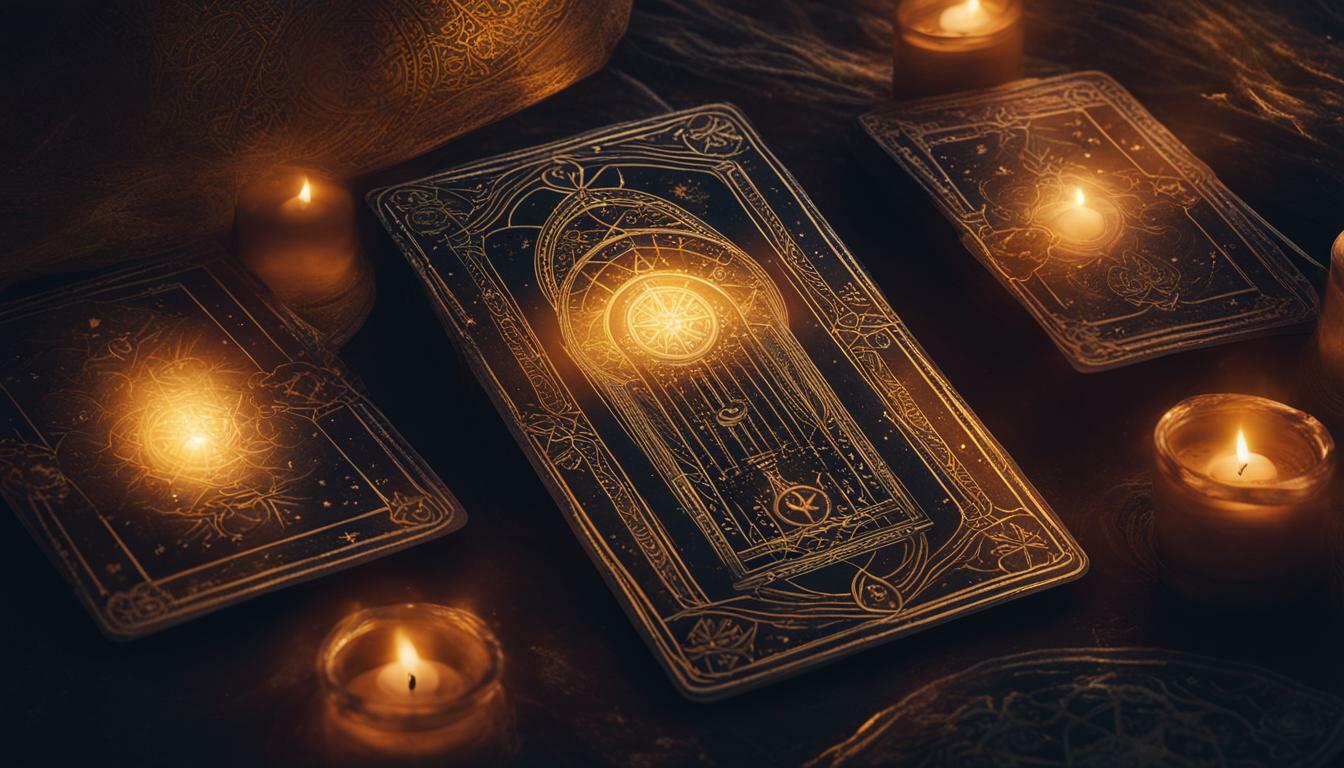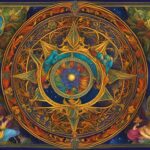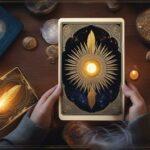Welcome to our guide on how to read tarot card meanings. If you’re curious about unlocking the secrets of tarot and taking your first steps into the mystical world, you’ve come to the right place.
To read tarot card meanings, it is important to understand that each card in the deck has its own unique meaning. The tarot deck consists of 78 cards, with the Major Arcana representing major life events and the Minor Arcana representing everyday aspects of life. The Major Arcana cards focus on aspects of the self and reflect universal archetypes, while the Minor Arcana cards represent emotions, passion, thoughts, and material matters. Choosing a tarot deck that speaks to you is crucial, as your intuition and connection to the cards will guide your interpretation.
There are various types of tarot readings, including general readings, question-based readings, past-present-future readings, and yes/no readings. The process of reading tarot cards involves shuffling the deck, setting an intention, laying out the cards in a spread, and interpreting the cards and their positions. Trusting your intuition and reflecting on the reading are essential for gaining insight and guidance. It is also important to choose a deck that resonates with you, whether it be the Rider-Waite deck, the Black Power Tarot deck, the Aleister Crowley Thoth Tarot deck, the Slutist Tarot deck, or the Marseille Tarot deck. Remember that tarot is a tool of divination and self-improvement, and its real power lies within you.
Key Takeaways:
- Each card in the tarot deck has its own unique meaning.
- The Major Arcana represents major life events, while the Minor Arcana represents everyday aspects of life.
- Choosing a tarot deck that resonates with you is important for intuitive interpretation.
- There are various types of tarot readings, including general, question-based, past-present-future, and yes/no readings.
- The process of reading tarot cards involves shuffling, setting intention, laying out the cards, and interpreting their positions.
Understanding the Tarot Deck
Before we jump into reading tarot card meanings, let’s familiarize ourselves with the tarot deck itself and the symbolism it holds. The tarot deck consists of 78 cards, divided into two main categories: the Major Arcana and the Minor Arcana.
The Major Arcana cards are the heart of the deck, representing significant life events and spiritual lessons. These cards often depict archetypal figures, such as The Fool, The Magician, and The World, each carrying a deep symbolic meaning that reflects universal truths and experiences.
On the other hand, the Minor Arcana cards represent everyday aspects of life, including emotions, passions, thoughts, and material matters. Divided into four suits – Cups, Pentacles, Swords, and Wands – these cards offer insights into various areas of our lives, providing guidance and clarity.
Each tarot card is adorned with intricate imagery and symbolism that adds layers of meaning to the reading. Learning to decipher these symbols is essential for understanding the deep wisdom and messages each card holds. Take your time to explore the imagery, colors, and patterns on the cards, allowing your intuition to guide you towards a deeper connection with the deck.
Symbolism in Tarot Cards
The symbolism in tarot cards is vast and varied, with each card carrying its unique set of symbols and meanings. These symbols can range from elements of nature, like flowers and animals, to celestial bodies, such as the sun and moon, to ancient spiritual and mythological figures.
For example, the High Priestess card often features a crescent moon, symbolizing intuition and mystery, while the Tower card depicts a crumbling tower, representing sudden change and upheaval. These symbols, along with the overall imagery and position of the cards in a spread, contribute to the overall message and interpretation.
By studying the symbolism in tarot cards, you can develop a deeper connection with the deck and uncover hidden layers of insight and guidance. Allow yourself to be open to the messages the cards have to offer and trust your intuition as you delve into the world of tarot.
Table: Quick Reference Guide to Tarot Card Symbolism
| Tarot Card | Symbol | Meaning |
|---|---|---|
| The Fool | A dog | Trust and loyalty |
| The Magician | Infinity symbol | Infinite possibilities and manifestation |
| The High Priestess | Crescent moon | Intuition and mystery |
| The Empress | A cornucopia | Fertility and abundance |
Understanding the symbolism in tarot cards is an ongoing journey. As you continue to explore the deck and deepen your connection with each card, you’ll uncover new layers of meaning and interpretation. Remember, tarot is a tool of self-discovery, reflection, and guidance, and the more you engage with it, the more it will reveal to you.
Types of Tarot Readings
Now that you have a basic understanding of the tarot deck, let’s explore the various types of tarot readings you can do and how to interpret the cards in different spreads.
1. General Readings: These readings provide a broad overview of your current situation and can offer guidance in multiple areas of your life. The cards drawn in a general reading may reveal insights into your relationships, career, spiritual path, or personal growth.
2. Question-Based Readings: If you have specific questions or concerns, a question-based reading can provide focused answers. You can ask the tarot deck a specific question, and the cards drawn will offer guidance and insight regarding the matter at hand.
| 3. Past-Present-Future Readings: | 4. Yes/No Readings: |
|---|---|
| These readings examine the past, present, and future aspects of a situation or issue. The cards drawn in each position shed light on how past events have influenced the present and offer guidance on what may unfold in the future. | In a yes/no reading, the tarot cards are used to provide a straightforward answer to a specific question. Each card drawn represents a yes or no response, helping you gain clarity on a particular matter. |
Interpreting the cards and their positions in different spreads is an integral part of tarot reading. Spreads are specific arrangements of cards that provide a framework for interpreting their meanings. Some common spreads include the Celtic Cross, Three-Card Spread, and the Past-Present-Future Spread.
Interpreting Tarot Cards
When interpreting tarot cards, it’s important to trust your intuition and look beyond the surface-level meanings. The symbolism of each card, the position it occupies in the spread, and the overall energy and flow of the reading all contribute to its interpretation.
“The tarot is a mirror that reflects aspects of yourself and your life. It is a tool that helps you tap into your own inner wisdom and explore the depths of your consciousness.” – Unknown
Remember, tarot is a powerful tool for self-reflection, personal growth, and gaining insight into your life’s journey. The true power of tarot lies within you, and by exploring the different types of readings and developing your interpretation skills, you can unlock its transformative potential.
The Reading Process
Now that you’re ready to start your tarot reading, let’s go through the process step-by-step to ensure a meaningful and insightful experience. The first step is to shuffle the deck. This helps to infuse your energy into the cards and create a connection with the divine. As you shuffle, think about the question or area of your life you want guidance on.
Next, set your intention. This is an important part of the reading process as it helps to focus your energy and intentions. Take a moment to think about what you hope to gain from the reading and how you want to use the guidance from the cards. You can say a prayer or simply state your intention silently.
Once you have shuffled the deck and set your intention, it’s time to lay out the cards in a spread. There are various spreads you can use, such as the Celtic Cross or the Three-Card Spread. Choose a spread that resonates with you and fits the type of reading you want to do. Each position in the spread represents a different aspect of the situation or question at hand.
As you begin interpreting the cards, trust your intuition and let your instincts guide you. Pay attention to the imagery, symbolism, and colors on each card. Consider how they relate to the question or area of your life you are seeking guidance on. Reflect on the cards and their positions in the spread, exploring the connections and patterns that emerge.
Remember, the true power of tarot lies within you. The cards are merely a tool to help tap into your own inner wisdom and intuition. Use them as a guide and trust the messages that come through. With practice and an open mind, tarot can become a powerful tool for self-reflection, personal growth, and spiritual connection.
| Step | Description |
|---|---|
| 1 | Shuffle the deck |
| 2 | Set your intention |
| 3 | Lay out the cards in a spread |
| 4 | Interpret the cards and their positions |
| 5 | Trust your intuition and reflect on the reading |
Choosing the Right Tarot Deck
Choosing the right tarot deck is a crucial step in your tarot journey, as it will greatly influence your intuitive connection with the cards. Let’s explore some popular decks to help you find the one that speaks to you.
1. Rider-Waite Deck: Known as the standard deck, the Rider-Waite deck features vibrant illustrations and rich symbolism. It is a great choice for beginners and experienced readers alike.
2. Black Power Tarot Deck: This deck celebrates Black history and culture, offering a unique perspective and empowering messages. It embraces themes of resilience, spirituality, and social justice.
3. Aleister Crowley Thoth Tarot Deck: Designed by influential occultist Aleister Crowley, this deck boasts intricate artwork and esoteric symbolism. It delves into mysticism, spirituality, and the subconscious mind.
4. Slutist Tarot Deck: Created by sex-positive feminist collective Slutist, this deck challenges traditional tarot imagery and explores themes of empowerment, sexuality, and self-expression.
5. Marseille Tarot Deck: This historic deck dates back to the 15th century and features simple yet powerful illustrations. It is renowned for its traditional symbolism and straightforward interpretation.
Which Deck Should You Choose?
When selecting a tarot deck, consider the artwork, symbolism, and themes that resonate with you. Trust your intuition and choose a deck that speaks to your personal journey, interests, and aesthetics. Take your time exploring different decks to find the one that sparks a connection and inspires your readings.
| Tarot Deck | Description |
|---|---|
| Rider-Waite Deck | Vibrant illustrations and rich symbolism, suitable for beginners and experienced readers. |
| Black Power Tarot Deck | Celebrates Black history and culture, empowering messages of resilience and social justice. |
| Aleister Crowley Thoth Tarot Deck | Intricate artwork and esoteric symbolism, delves into mysticism and the subconscious mind. |
| Slutist Tarot Deck | Challenges traditional tarot imagery, explores themes of empowerment and sexuality. |
| Marseille Tarot Deck | Simple yet powerful illustrations with traditional symbolism, straightforward interpretation. |
Remember, the tarot deck you choose is a reflection of your unique journey. Let your intuition guide you to the deck that resonates with your energy and opens up a world of meaningful insights and self-discovery.
What are the Basic Tarot Card Reading Techniques for Beginners?
Learning to read tarot cards can be daunting for beginners, but with these tarot card reading tips, you’ll be well on your way. Start by familiarizing yourself with the meanings of each card, then learn different card spreads like the Celtic Cross or Three-Card Spread. Practice intuition and develop your own unique interpretation style. Always remember that practice makes perfect in the world of tarot card reading.
Conclusion
Congratulations! You’ve reached the end of our guide on how to read tarot card meanings. Remember, tarot is not just a mystical practice but a tool for personal growth and self-discovery. Trust your intuition, embrace the guidance of the cards, and embark on your tarot journey with confidence and curiosity.
To read tarot card meanings, it is important to understand that each card in the deck has its own unique meaning. The tarot deck consists of 78 cards, with the Major Arcana representing major life events and the Minor Arcana representing everyday aspects of life. The Major Arcana cards focus on aspects of the self and reflect universal archetypes, while the Minor Arcana cards represent emotions, passion, thoughts, and material matters.
Choosing a tarot deck that speaks to you is crucial, as your intuition and connection to the cards will guide your interpretation. There are various types of tarot readings, including general readings, question-based readings, past-present-future readings, and yes/no readings. The process of reading tarot cards involves shuffling the deck, setting an intention, laying out the cards in a spread, and interpreting the cards and their positions. Trusting your intuition and reflecting on the reading are essential for gaining insight and guidance.
It is also important to choose a deck that resonates with you, whether it be the Rider-Waite deck, the Black Power Tarot deck, the Aleister Crowley Thoth Tarot deck, the Slutist Tarot deck, or the Marseille Tarot deck. Remember that tarot is a tool of divination and self-improvement, and its real power lies within you.








